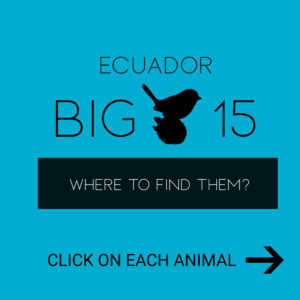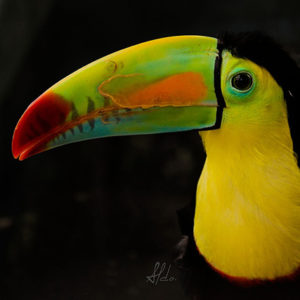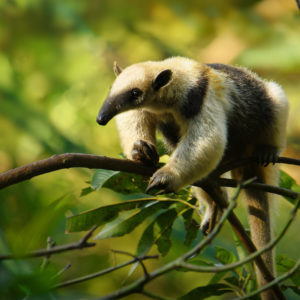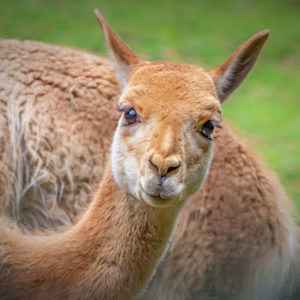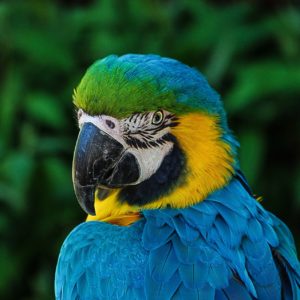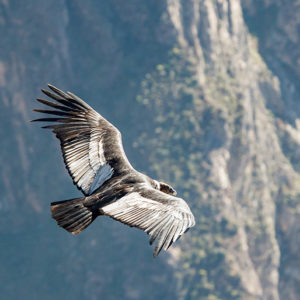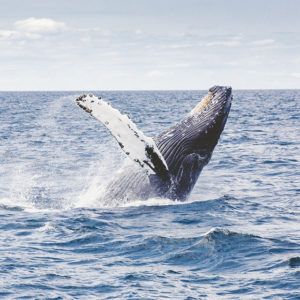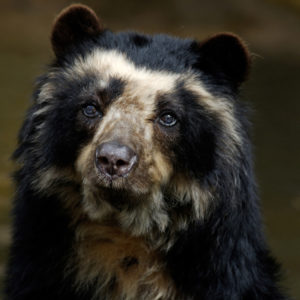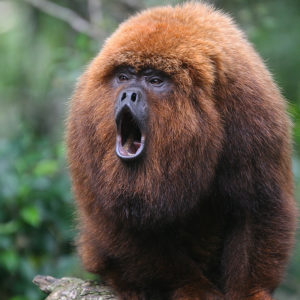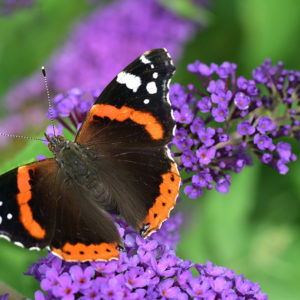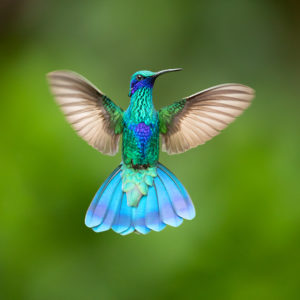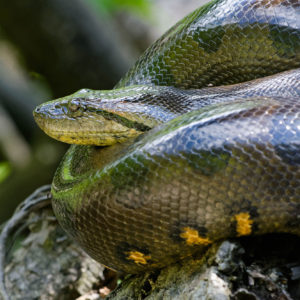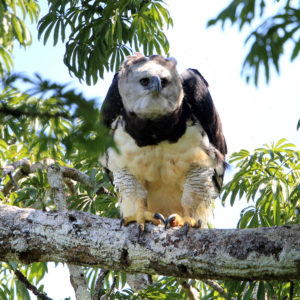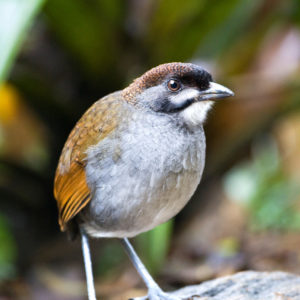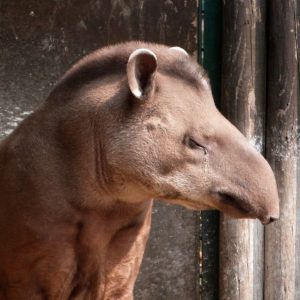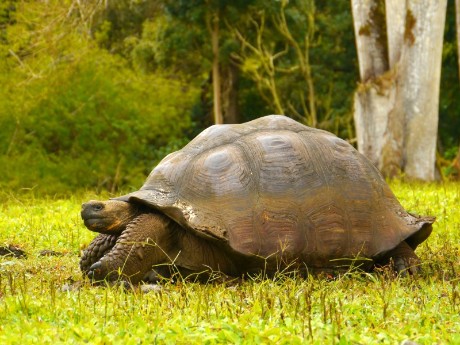Ecuador Tours - Ecuador Big 15
DISCOVER YOUR ULTIMATE WILDLIFE EXPERIENCE
ECUADOR BIG 15
We connect you with the wildlife in Ecuador
1. Spectacled Bear
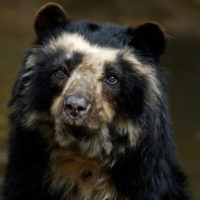
The curious looking Spectacled Bear with white rings and patches around their eyes is the only bear native to South America and is also known as the Andean Bear. The shy and solitary shaggy bears enjoy climbing trees and can sit in a tree for days! While the bears are known to be quite adaptable, they are largely found in the Andean forest and are still considered to be endangered in Ecuador. Nevertheless, with recent efforts to protect them and their habitats, the numbers of Spectacled Bear in Ecuador are rising. Out of the estimated population of 20,000 bears in South America, at least 2000 are thriving in Ecuador. The suggested tours below will bring you to some of the best spots to see the spectacled bears.
🔍Where to find them: Maquipucuna Cloud Forest Reserve and Lodge, Hacienda Zuleta Bear Sanctuary, Antisana Ecological Reserve and Hacienda Pimán.
⏱️Best time to see them: All year round & breeding season is at its peak between April and June
Antisana Volcano Hiking Tour: Alexander von Humboldt's Trail
Day tour with hikes through the idyllic highlands and under the snow fields of the volcano Antisana
Ecuador Cloud Forest: 3 Days Maquipucuna Ecolodge
Explore the beautiful cloudforest of Nanegal and the surrounding area
Ecuador Mountain Cloud Forest 4-Days Maquipucuna Ecolodge
Explore the cloud forest region of Nanegal and surroundings
Hacienda Pimán : Discover the north of Ecuador (3)
Discover the magical Andean landscapes, indigenous markets and spot the spectacled bear
A Spectacled bear excursion at Hacienda Pimán
Discover the dreamy Andean landscapes, indigenous markets and spot the spectacled bear
2. Condor
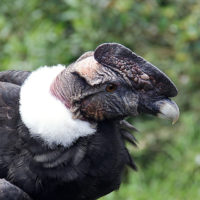
The magnificent Andean Condor is part of the vulture family and is also the largest flying bird in the world. The Condor is extremely symbolic in South American culture is often represented in art, used in the national coat of arms and the word condor comes from the Quechua word, kuntur. Even though the Condors have a long lifespan of over 50 years, the International Union for the Conservation of Nature has declared the Andean Condor near threatened. This is due to hunting, and the condors consuming poisoned meat. It is believed that there are only around 50 Andean Condors in Ecuador and they spend most of their time soaring in the skies above 5,000 meters and nesting on rocky terrains. The suggested tours below will bring you to some of the best spots to see the Condor in Ecuador.
🔍Where to find them: Andes Condor Park, Andean Condor Huasi Project at Hacienda Zuleta and nearby Antisana Volcano.
⏱️Best time to spot them: Dry Season (April to November) at 8 am-10 am and from 3:30 pm-4:30 pm.
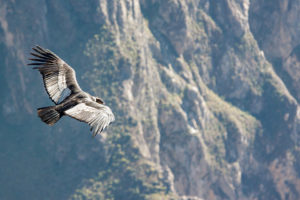

Gruppenreise Ecuador und Galapagosinselhopping
Duration: 14 - 14 daysHighlights:
Erkunden Sie Ecuador und die Galapagosinseln mit deutschsprachiger Reiseleitung und Naturführer
Price per pax
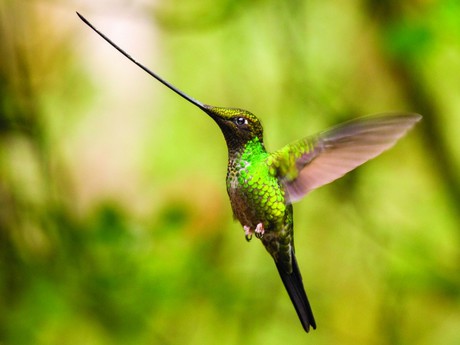
Ecuador Reserve Tour: Birdwatching Tour (Yanacoha & Mindo)
Duration: 2 - 2 daysHighlights:
Discover 40+ hummingbird species on the "hummingbird Promenade"
Price per pax

Ecuador Reserve Tour: Yanacocha and Tandayapa Valley (2)
Duration: 3 - 3 daysHighlights:
Discover 40+ hummingbird species on the "hummingbird Promenade"
Price per pax
3. Parrot
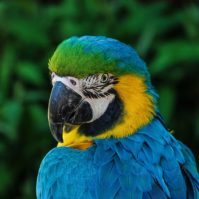
Ecuador is a stunning bird paradise with over 1,600 bird species and more than 20 species of parrots, macaws, and parakeets. While we are no stranger to the brightly coloured and sometimes noisy parrots, did you know that they are endangered? These vibrant singers are threatened by deforestation, hunting and illegal trade. A star among parrots in Ecuador are the Great Green Macaws and is the largest parrot in the world. Visitors eager to see them up close can visit the Historical Park in Guayaquil or visit the two clay licks at Yasuni National Park. Clay licks are important patches of earth which is high in minerals and sodium which help to neutralize the toxins from their high nut and seed diet. At the first clay lick you can find the dusky-headed parakeet, white-eyed parakeet, blue-headed parrot, yellow-crowned Amazon Parrot, and the Mealy Amazon Parrot. The second clay lick which is located deeper in the forest are frequented by the Cobalt-winged Parakeet, Orange-cheeked Parrot, Scarlet-shouldered Parrot, Scarlet Macaw and the Red and Green Macaw.
🔍Where to find them: Guayaquil Historical Park and Yasuni National Park
⏱Best time to spot them: All year round, at around 7am (clay licks)
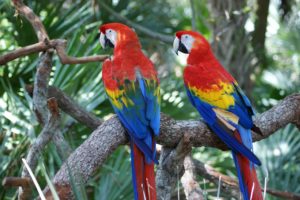
Guayaquil - Excursion: Historical Park (3h)
Travel back in time while visting the Guayaquil Historical Park.
4. Hummingbird
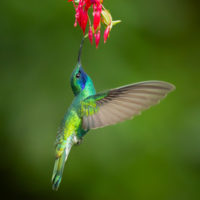
These vibrantly coloured songbirds need little introduction and Ecuador is home to at least 132 species of hummingbirds! That is the highest recorded number of hummingbirds in a single country. Hummingbirds are the smallest type of bird in the world and in Ecuador, they can be found in both the forest area and high up in the Andes and some are also endemic, such as the gorgeous Velvet-purple Cornet, Purple- bibbed Whitetip, Brown Inca, Empress Brillant and Gorgeted Sunangel. The largest concentration of hummingbird is amid the cloud forest. To attract females during breeding season, the male Hummingbirds usually display its colorful plumage, bob and hop, and make strident calls which is quite a sight to behold. Bird feeders along birdwatching routes will bring you closer to these beautiful birds.
🔍Where to find them: Mindo Area, Yanacocha Reserve near Quito and Antisanilla Reserve (by Jocotoco Foundation) and at the Guango Lodge.
⏱Best time to spot them: All year round but especially during the rainy season from December to April which is also the mating and nesting season.
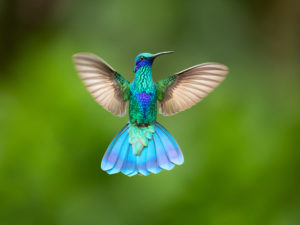

Day Tour: Yanacocha Reserve Birdwatching
Duration: 1 - 1 daysHighlights:
Birdwatching close to Quito with an expert bilingual guide from the Jocotoco Foundation for Conservation.
Price per pax

Ecuador Reserve Tour: Yanacocha and Tandayapa Valley (2)
Duration: 3 - 3 daysHighlights:
Discover 40+ hummingbird species on the "hummingbird Promenade"
Price per pax

Ecuador's Southern Bird Reserve Tour
Duration: 9 - 14 daysHighlights: Jocotoco antpitta, Podocarpus National Park, Tapichalaca Reserve, Black-breasted puffleg hummingbirds, Utuana region, Jorupe Reserve, Buenaventura Reserve, Choco- and Tumbes region, Coati, Yanacocha Reserve
The reserves in the south of Ecuador show a unique variety of bird species.
Price per pax
5. Frogs
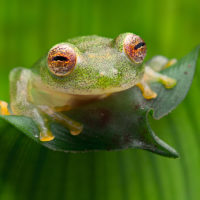
There are at least around 600 known species of amphibians in Ecuador alone and 15.9% are endemic to the tropical rainforest in Ecuador! The humid climate in the Amazon allows them to maintain proper respiration through their skin. While the Amazon is home to most of the amphibian population, their adaptability and evolution allowed some to live on the lowlands and even up in the cloud forest close to the Andes. Researchers however estimated that there are over 1000 species that are not discovered yet. In Yasuni National Park, there are at least 130 amphibian’s species! However, amphibians in Ecuador are threatened by oil exploration and production in the area which leads to water pollution in the streams and water sources where frogs release their eggs. A species recently discovered is the glass frog (Centrolene prosoblepon), where in some cases they are so transparent, you can even see the heart beating! The suggested tours below will bring you to some of the best spots to see the colorful and many different frogs in Ecuador.
🔍Where to find them: Amazon Rain and Cloud Forest espcially at Yasuni National Park, Mindo, Hakuna Matata Lodge, Guango Lodge, Napo Wildlife Center, Un Poco Del Choco Reserve and Biological station.
⏱Best time to spot them: All year round

Ecuador Cloud Forest: 3 Days Guango Lodge
Duration: 3 - 3 daysHighlights:
The cozy Guango Lodge is surrounded by rainforest and bird swarms at 2,700 meters.
Price per pax

Ecuador Rainforest: 4 Days Hakuna Matata Lodge, Tena
Duration: 4 - 4 daysHighlights:
This program offers you a superb time with the highlights of the Amazon rainforest
Price per pax

Thirst for knowledge: El Chocó Biologic Station (3)
Duration: 3 - 3 daysHighlights:
Study with us the incredible amount of endemic species of this unique microclimate
Price per pax

Ecuador Cloud Forest: 2 Day Mindo Tour
Duration: 2 - 2 daysHighlights:
The mountain cloud forest on the western Andes is famous for its dense flora and best birdwatching.
Price per pax
6. Vicuña
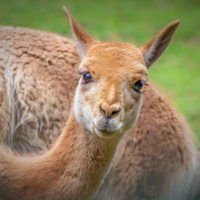
Vicuñas are relatives of Llamas but they are smaller and their diet mainly consist of grass and salt which they lick from rocks. An average Vicuña weighs around 150 pounds and are usually quite shy and alert to their surroundings. They are also known for their extremely soft and warm fuzzy wool. In 1974, they were considered to be endangered due to excessive hunting but with successful conservation efforts, there are at least 350,000 Vicuñas in the wild at the moment. Today there are over 6000 Vicuñas at the Chimborazo Faunal Production Reserve alone! You can usually find them grazing at the grasslands and slopes of the Andes. The suggested tours below will bring you to some of the best spots to see Vicuñas in Ecuador.
🔍Where to find them: Chimborazo National Park
⏱Best time to spot them: All year round
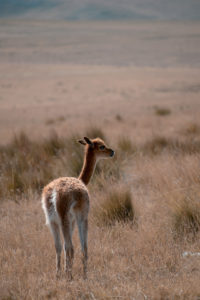

Ecuador Summiting: 2 Day Chimborazo climb
Duration: 2 - 2 daysHighlights:
Experience the highest volcano in Ecuador with experienced mountain guides
Price per pax

Ecuador Summiting: 4 Day Chimborazo with Acclimatisation
Duration: 4 - 4 daysHighlights:
Experience the highest volcano in Ecuador with experienced mountain guides
Price per pax

Summit Striker: Cayambe and Chimborazo
Duration: 12 - 25 daysHighlights: Chimborazo mountaineering, Pinchincha, Pasochoa, Cayambe, Cotopaxi, Devil's Nose, Guayaquil, Available for groups of 2+, English speaking mountain guide, Flexible travel dates, 12 days, 11 nights, Includes transfers and hotels, Includes mountain tours, Excludes international flights, From € 2,200 per person in double room
This trip combines the ascent of the volcano Cayambe with the ascent of the Chimborazo.
Price per pax
7. Butterflies

Being immensely diverse in its flora and fauna, Ecuador has at least 4000 species of butterfly, and often within a single trip, visitors can see up to 750 species. An abundance of butterflies is often an indication that an ecosystem is thriving. Ecuadorian Butterflies can be found in both the Andes and the Amazon Rainforest. Trained tour guides will be able to help you identify the butterfly species during your tour and who knows, you might even help to discover a new species! Some of the best places to see butterflies is in Mindo with their “butterfly farms” and in Papallacta. The suggested tours below will bring you to some of the best spots with the most concentrated number of butterflies in Ecuador.
🔍Where to find them: Mindo and Papallacta
⏱Best time to spot them: All year round
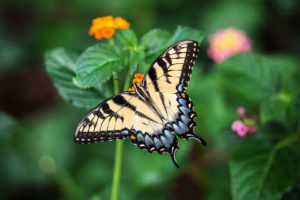
Ecuador Cloud Forest: 2 Day Mindo Tour
The mountain cloud forest on the western Andes is famous for its dense flora and best birdwatching.
Ecuador Reserve Tour: Birdwatching Tour (Yanacoha & Mindo)
Discover 40+ hummingbird species on the "hummingbird Promenade"
8. Jocotoco
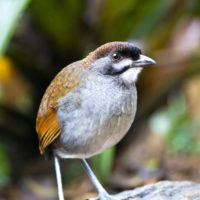
The Jocotoco Antpitta is an endangered bird found in small numbers in Ecuador and Peru. The name is onomatopoetic after its hooting calls and song, it is also said to sound like an owl. It was only discovered in 1997 and can be found in only 5 locations in the world. Their declining numbers is due to the loss of habitat from mining, agriculture and deforestation. To protect the presumably small population, the Tapichalaca Biological Reserve was established on behalf of Fundación de Conservación Jocotoco in 1998. More recently, Jocotoco Antpittas have been observed in Podocarpus National Park, which borders the reserve. It is estimated that there are only 150 to 700 Jocotocos in the wild today. Visitors can stay at the lodge at Jocotoco Reserve, to catch a glimpse of this rare and unique bird. Along with experienced tour guides, the suggested tours below will bring you to some of the best spots to see the Jocotocos in Ecuador.
🔍Where to find them: Jocotoco Reserve or Podocarpus National Park
⏱Best time to spot them: All year round
Ecuador's Southern Bird Reserve Tour
The reserves in the south of Ecuador show a unique variety of bird species.
9. Anaconda
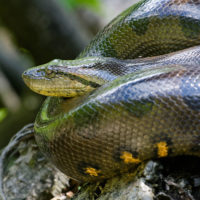
The infamous anaconda is the largest snake in the world, and the second longest (the first being the python). According to a documentary from BBC, a 17-foot (5.18meters) long anaconda in Ecuador was discovered while they were filming another show. Anacondas can live up to 10 years in the wild, and are solitary unless they want to mate. Contrary to popular belief, anacondas are not venomous. There are four species of anaconda – the green anaconda, the yellow or Paraguayan anaconda and the dark-spotted anaconda. The green anaconda (Eunectes murinus) is the most common species in South America, and you can find them resting in shallow waters or on trees. It is usually quite safe to go near them, especially after they have eaten. The Yasuni National Park is one of the best places to see anacondas with a guided tour!
🔍Where to find them: Amazon Rainforest especially at Yasuni National park
⏱Best time to spot them: All year round, mating season is April to May (to witness a special mating ‘wrestle’ among male ancondas as they fight for the female)
Ecuador Rainforest: 4 Days Cuyabeno Lodge, Cuyabeno
Discover the Amazon rainforest of Ecuador
Ecuador Rainforest: 4 Days Hakuna Matata Lodge, Tena
This program offers you a superb time with the highlights of the Amazon rainforest
Ecuador Complete: Amazon, Andes and Galapagos Islands
Discover the many faces of the world's most biodiverse country!
10. Howler Monkey

As the name suggests, the Mantled Howler Monkey emits loud howling noises at dusk and dawn and can be heard up to 3 miles away. If you are woken up by their howling, you can be sure that these loud tree-climbing sound boxes are not too far from your vicinity. They are native to Central and South America. Like many other animals in the rainforest, their habitat is constantly threatened by deforestation. According to a recent research, the population of Howler Monkey in protected areas and recovering secondary forest close to Guayaquil in Ecuador is around 47 monkeys per km2. It is good news that they are willing to return to recovering secondary forest areas. The Howler Monkey’s diet mainly consists of leaves, fruits and flowers. They are social animals and prefer to live in groups, so visitors can expect to see them in larger numbers. Our recommended tours below will bring you to the best spots in Ecuador to see the Mantled Howler Monkey.
🔍Where to find them: Mashpi Lodge, Pacoche Lodge, Yasuni National Park, La Selva Lodge and at the Ecuadorian Coast (Mantaraya Lodge)
⏱Best time to spot them: All year round, babies are usually born between December to January

Ecuador Rainforest: 4 Days La Selva Lodge, Yasuní
Perfect for all sorts of adventurous travelers. A luxury resort on the heart of the rainforest.
Ecuador Coast: Mantaraya Lodge (5)
Discover the unique nature of the Ecuadorian Coast
Cloud Forest 3-Days Mashpi Lodge - from Mindo
Multiple award winning lodge with breathtaking nature and design.
11. Whale
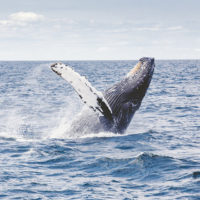
The humpback whale may be a surprise on this list as Ecuador is known for its greenery and lush forests, but the coastal region in Ecuador has many amazing and astonishing nature in store for visitors as well. From June to October, the humpback whales travel 4000 miles from Antartica to mate and give birth in the warmer waters in Ecuador. The Humboldt Current, which runs near the coast of Ecuador, stirs up large amounts of plankton and krill, which the humpback whales, as well as many other types of whales and dolphins, require to thrive and to raise their young. While at Ecuador, they eat enough to survive the rest of winter. It is a wonderful time to watch whales during this period as many of them leap out of the water to attract mates. Some of the best places for whale watching in Ecuador are Puerto Lopez, Salinas, Bahia de Caraquez, and Mompiche. Puerto Lopez is particularly attractive for whale watching as it offers tours to nearby Isla de la Plata and it also has the amazing Machalilla National Park nearby. Select from one of our personally curated whales watching tours below!
🔍Where to find them:Puerto Lopez, Salinas, Bahia de Caraquez, and Mompiche
⏱Best time to spot them: Late June to October
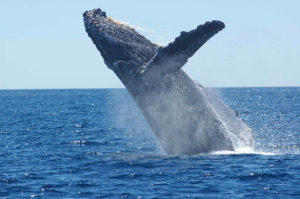

Galapagos PRO Recommendation: Whale Watching Canoa
Duration: 1 - 1 daysHighlights:
Great observation of whales off the coast of Ecuador at Canoa
Price per pax

Ecuador Coast 2-Day Puerto Lopez & Isla de la Plata
Duration: 2 - 2 daysHighlights:
Visit "Little Galapagos" and the beautiful coastal area around Puerto Lopez.
Price per pax

Azoren - Wale beobachten und schwimmen mit Delfinen
Duration: 15 - 15 daysHighlights:
Begegnen Sie den „Giganten der Weltmeere“ bei den Whale-Watching-Ausfahrten.
Price per pax
12. Anteater
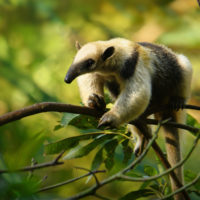
There are four species of Anteater in Ecuador and the most common one is the Tamandua Mexicana, which is frequented sighted in Mashpi. They are active day and night, and while they climb trees and travel on the ground, they are rather clumsy. The tamandua is not considered endangered by the IUCN (International Union for Conservation of Nature), but there is a reduced population in Ecuador due to the local belief that they attack domestic dogs. Tamanduas are not known to be aggressive, although when threatened they will rise onto their rear legs and swipe with their strong arms and long claws like a boxer. Interestingly, this boxing behaviour is also part of their courtship ritual which fortunate visitors may have the opportunity to enjoy. They prey on ants and termites which are found abundantly in all types of forest, so the tamandus can be quite easily spotted. The suggested tours below will bring you to the best spots to see the cute tamandua.
🔍Where to find them: Mashpi Lodge, Napo Wildlife Center and Yanacocha Reserve
⏱️Best time to spot them: All year round (Mating season is between March and May)

Ecuador Rainforest: 4 Days Cuyabeno Lodge, Cuyabeno
Discover the Amazon rainforest of Ecuador
Ecuador Complete: Amazon, Andes and Galapagos Islands
Discover the many faces of the world's most biodiverse country!
13. Toucan
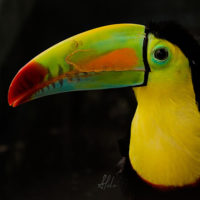
The beautiful Toucan is known for their long, colourful and strong beaks. There are around 19 species of Toucans in Ecuador! The Choco toucan (Ramphastos brevis) is only found in South America and most commonly in Ecuador. They are mainly located in primary forest and only go to secondary forest to forage for food. Toucans breed between March to October, and they may even breed twice as a pair within a year. Their diet mainly consists of fruit and occasionally insects and seeds. The best place to watch Toucans is in Mindo, which is 2 hours northwest from Quito. If you are looking out for them, remember that Toucans do not build nests but instead live in hollowed-out sections of tree trunks. The other two commonly sighted species of Toucan in Mindo are the Crimson-rumped Toucanet (Aulacorhynchus haematopygus) and the Pale-mandibled Aracari (Pteroglossus erythropygius). Check out our guided tours below as we bring you to the bird paradise of Ecuador.
🔍Where to find them: Mindo and Guayaquill Historical Park
⏱Best time to spot them: All year round.
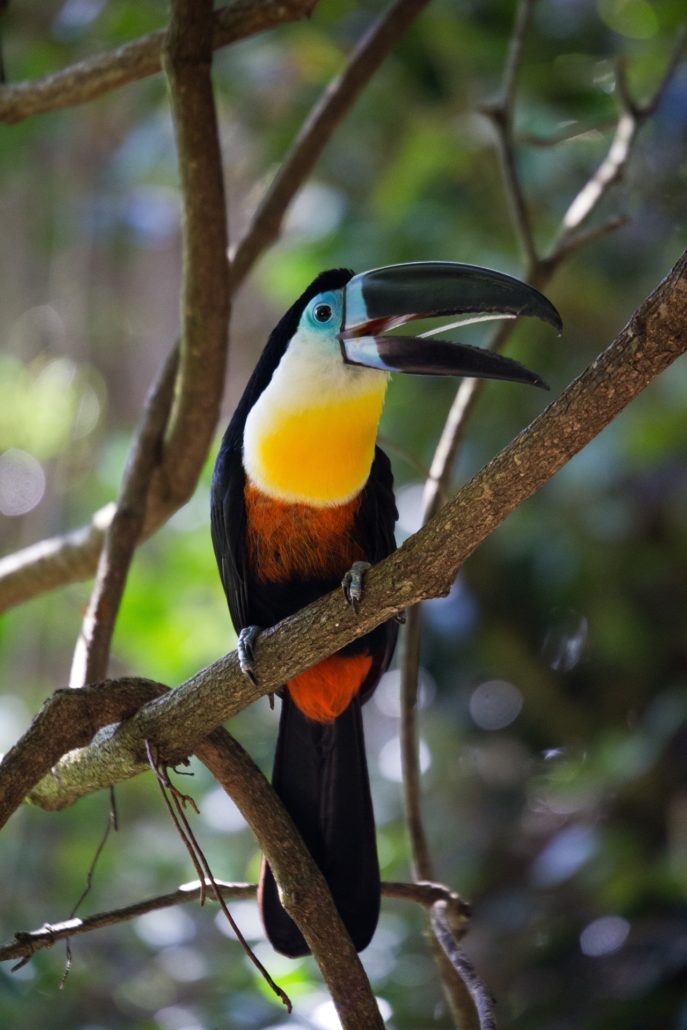

Ecuador Rainforest: 4 Days Cuyabeno Lodge, Cuyabeno
Duration: 4 - 4 daysHighlights:
Discover the Amazon rainforest of Ecuador
Price per pax

Ecuador Rainforest: 4 Days Tapir Lodge, Cuyabeno
Duration: 4 - 4 daysHighlights:
Experience monkeys, frogs, birds, insects and the indigenous lifestyle during your stay at the Tapir Lodge.
Price per pax

Ecuador Reserve Tour: Birdwatching Tour (Yanacoha & Mindo)
Duration: 2 - 2 daysHighlights:
Discover 40+ hummingbird species on the "hummingbird Promenade"
Price per pax
14. Harpy
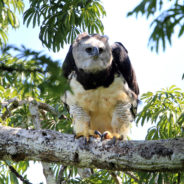
Do not be deceived by the gorgeous crested harpy. It is considered to one of the most powerful raptors out there in the rainforest and is notorious for tearing its prey apart with its sharp claws. It feeds mainly on sloths and monkeys. There are around 20,000-50,000 harpies in the world, but it is difficult to tell how many there are in Ecuador as they are very territorial and occupy large areas. Like the rest of the wildlife living in the rainforest, they face losing their habitat, and is now categorized as near threatened. If you want an absolute guarantee to see the Harpy, you can visit the Guayaquil historical park or the Condor Park, where they rescue raptors and birds which are too weak to survive in the wild. Our tours below will bring to the best spots to see the harpy.
🔍Where to find them: Sacha Lodge, La Selva Lodge and Condor Park, Cuyabeno Lodge and the Guayaquil Historical Park
⏱Best time to spot them: All year round
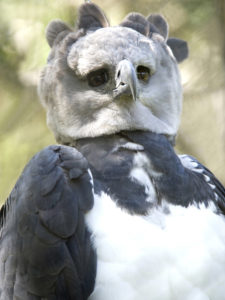
Ecuador Rainforest: 4 Days Cuyabeno Lodge, Cuyabeno
Discover the Amazon rainforest of Ecuador
Guayaquil - Excursion: Historical Park (3h)
Travel back in time while visting the Guayaquil Historical Park.
Ecuador Complete: Amazon, Andes and Galapagos Islands
Discover the many faces of the world's most biodiverse country!
15. Tapir
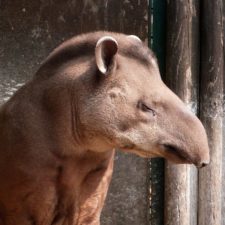
The sweet-looking and charismatic tapir is critically endangered and there are only 2500-3000 left in the wild! There are 5 species of Tapir left in the world, and the one in Ecuador is the South American Tapir (Tapirus terrestris), while 16 other species of tapir are already extinct. Tapirs are heavily hunted and their habitat is constantly destroyed by deforestation. The South American Tapir is the largest mammal native to South America and feeds mainly on fruits and leaves, and therefore play an important role in the ecology of their natural habitat by dispersing seeds. Tapirs have been sighted at the Yasuni National Park, Napo Wildlife Centre, and especially at clay licks. As they are nocturnal animals, the best time to see them would be late at night or early in the morning. There are also Tapirs at the Guayaquil historical park.
🔍Where to find them: Yasuni National Park, Napo Wildlife Centre, Guayaquil Historical Park and Tapir Lodge
⏱Best time to spot them: All year round (late at night and early in the morning)
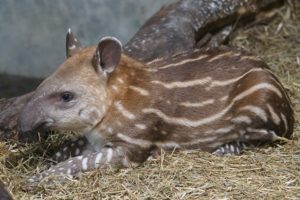
Ecuador Rainforest: 4 Days Cuyabeno Lodge, Cuyabeno
Discover the Amazon rainforest of Ecuador
Ecuador Rainforest: 4 Days Tapir Lodge, Cuyabeno
Experience monkeys, frogs, birds, insects and the indigenous lifestyle during your stay at the Tapir Lodge.
Guayaquil - Excursion: Historical Park (3h)
Travel back in time while visting the Guayaquil Historical Park.
